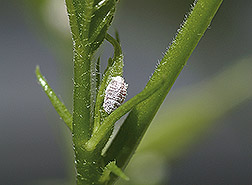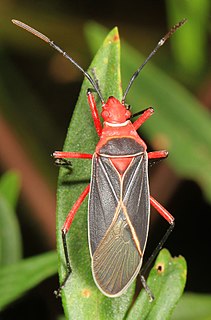
Thrips are minute, slender insects with fringed wings and unique asymmetrical mouthparts. Different thrips species feed mostly on plants by puncturing and sucking up the contents, although a few are predators. Entomologists have described approximately 6,000 species. They fly only weakly and their feathery wings are unsuitable for conventional flight; instead, thrips exploit an unusual mechanism, clap and fling, to create lift using an unsteady circulation pattern with transient vortices near the wings.

The silverleaf whitefly is one of several species of whitefly that are currently important agricultural pests. A review in 2011 concluded that the silverleaf whitefly is actually a species complex containing at least 40 morphologically indistinguishable species.

Maconellicoccus hirsutus, is a pest of many plants, trees, and shrubs. It infests hibiscus, citrus, coffee, sugar cane, annonas, plums, guava, mango, okra, sorrel, teak, mora, pigeon pea, peanut, grapevine, maize, asparagus, chrysanthemum, beans, cotton, soybean, cocoa, and many other plants. The pest forms colonies on the host plant, and if left undisturbed, the colonies will grow into large masses of white waxy coverings on branches, fruiting structures, leaves, and even whole plants, including large trees.

The western flower thrips [Frankliniella occidentalis (Pergande)] is an invasive pest insect in agriculture. This species of thrips is native to the Southwestern United States but has spread to other continents, including Europe, Australia, and South America via transport of infested plant material.

Psylla pyri, commonly known as the pear psylla or pear psyllid, is a true bug in the family Psyllidae. Originating in Europe and Asia, it has spread to North America. It is a pest of pear trees, sucking the sap, damaging the foliage, flowers and fruit and diminishing the crop.

The chilli thrips or yellow tea thrips, Scirtothrips dorsalis Hood, is an extremely successful invasive species of pest-thrips which has expanded rapidly from Asia over the last twenty years, and is gradually achieving a global distribution. It has most recently been reported in St. Vincent (2004) Florida (2005), Texas (2006), and Puerto Rico (2007). It is a pest of economic significance with a broad host range, with prominent pest reports on crops including pepper, mango, citrus, strawberry, grapes, cotton, tea, peanuts, blueberry, and roses. Chilli thrips appear to feed preferentially on new growth, and infested plants usually develop characteristic wrinkled leaves, with distinctive brown scarring along the veins of leaves, the buds of flowers, and the calyx of fruit. Feeding damage can reduce the sale value of crops produced, and in sufficient numbers, kill plants already aggravated by environmental stress. This thrips has also been implicated in the transmission of three tospoviruses, but there is some controversy over its efficiency as a vector.

The ringlegged earwig is a species of earwig in the family Anisolabididae.

Aleurocanthus woglumi is a species of whitefly in the family Aleyrodidae. It is a pest of citrus crops, and is commonly known as the citrus blackfly because of its slate-blue colour. It originated in Asia, but has spread to other parts of the world. The parasitic wasps, Encarsia perplexa and Amitus hesperidum can help control the pest.

Anthocoris nemoralis is a true bug in the family Anthocoridae. The species is native to Europe and is introduced in North America. It is a predator of aphids, spider mites and jumping plant lice, and is therefore used as a biological pest control agent.

Dysdercus suturellus is a species of true bug in the family Pyrrhocoridae, commonly known as a cotton stainer. The adult insect is slender, about 1 to 1.5 cm long, with a red thorax and dark brown wings marked with a yellow cross. It is native to the southeast of the United States, Jamaica and Puerto Rico. It is a pest of cotton crops and other plants, the adults and older nymphs feeding on the emerging bolls and the ripening seeds.

Thrips tabaci is a species of very small insect in the genus Thrips in the order Thysanoptera. It is commonly known as the onion thrips, the potato thrips, the tobacco thrips or the cotton seedling thrips. It is an agricultural pest that can damage crops of onions and other plants, and it can additionally act as a vector for plant viruses.
Frankliniella schultzei, the common blossom thrips or cotton thrips, is a species of thrips in the family Thripidae. It is found in many parts of the world and is an important pest insect in agriculture.
Pseudotheraptus wayi, the coconut bug, is a species of leaf-footed bug in the family Coreidae. It is a pest of coconut in East Africa.

Aspidiotus destructor, the coconut scale, is a species of armoured scale insect in the family Diaspididae, found in many tropical and subtropical parts of the world. It is a serious pest of coconut and banana, and attacks a range of other fruiting trees and ornamental plants.
Heliothrips haemorrhoidalis is a species of thrips in the family Thripidae. It is most commonly known as the greenhouse thrips, the glasshouse thrip or black tea thrips. This species of thrips was first described in 1833 by Bouché in Berlin, Germany. H. haemorrhoidalis also has many synonyms depending on where they were described from such as: H. adonidum Haliday, H. semiaureus Girault, H. abdominalis Reuter, H. angustior Priesner, H. ceylonicus Schultz, Dinurothrips rufiventris Girault. In New Zealand, H. haemorrhoidalis is one of the four species belonging to the subfamily Panchaetothripinae.

Leptoglossus gonagra, known as the passionvine bug, citron bug or squash bug in different parts of its range, is a species of leaf-footed bug in the family Coreidae. It is found in Africa, the Caribbean, Central America, North America, South America, Southern Asia, the Pacific Ocean and Oceania.
Pyrilla perpusilla, commonly known as the sugarcane planthopper, is a planthopper in the family Lophopidae. It is native to Asia where it feeds on grasses and other plants and is a major pest of sugarcane and sorghum.

Harmonia octomaculata is a species of ladybird of the family Coccinellidae. It is found throughout India, Pakistan, Nepal, Bangladesh, Sri Lanka, Micronesia, and Australia.
Afidenta misera, is a species of lady beetle widespread in the Oriental region.
Silana farinosa, commonly known as curry-leaf tortoise beetle, is a species of leaf beetle native to Indo-China, India, Sri Lanka, Thailand and introduced to Peninsular Malaysia.














